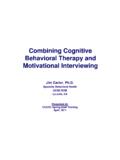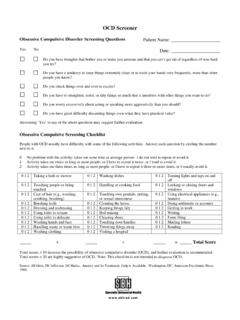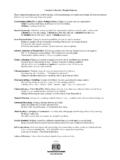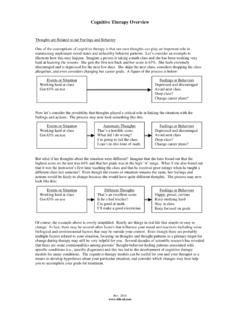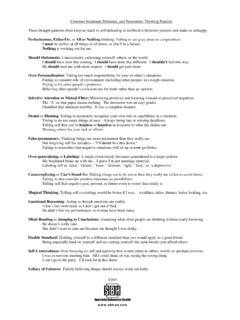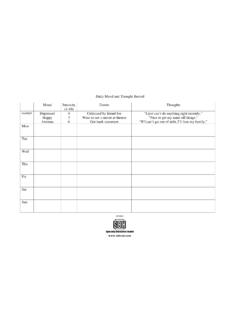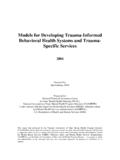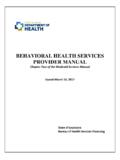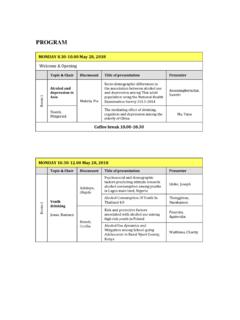Transcription of Combining Cognitive Behavioral Therapy and …
1 Combining Cognitive Behavioral Therapy and motivational InterviewingJim Carter, Behavioral health , La Jolla, CAUCSD SOMP resented At:39thAnnualSummer Clinical Institute In Addiction StudiesUCSD CCARTAA ugust 4th, 2010 CBT = Cognitive Behavioral TherapyMI = motivational InterviewingAgenda CBT for substance use MI for substance use Similarities and differences Rationale for Combining Ways to combine Possible models for combiningCBT Model of DisordersPredisposing FactorsPrecipitating Factors+Dysregulation in Function Behavioral System Cognitive System Affective SystemDysregulation in Substance Use Problems Cognitive Dysregulation Attention to positive and negative outcomes Attribution (internal vs. external) Decision making (risk taking) Self-efficacy Attitudes, beliefs, schemas Behavioral Dysregulation Positive and negative reinforcement Conditioning (cue reactivity) Displaced reinforcementsCBT Process Case conceptualization Time-limited and solution-focused Structured and directive Individual and/or group format Sound therapeutic relationship is essential Educative and skill-building processes Socratic method Role play, rehearsal, shaping Homework Examples of CBT Topics for Substance Use Problems Triggers and decision points Coping with urges and cravings Handling social pressures Catching and challenging distorted beliefs Emotional regulation ( , anger mgt.)
2 Daily planning and routine (occupation) Re-establishing trust with social supportsMI for Substance Use Problems Not driven by theory or model Focuses on building client motivation Client primarily responsible for change Provider elicits, guides, and supports No specific assumptions regarding course of treatmentMI Process Brief - Individual meeting(s) with client Spirit of MI provider Collaborative Respects client s autonomy Evocative Client-centered aspects ( reflective listening, open-ended questions) Provider guides client toward change Strengthen commitment to action planOpen vs. Close-Ended QuestionsDemonstration Is it worth the time to use open-ended questions?Close-EndedOpen-EndedIs it brown?How does it look?Does it live on land?
3 Where does it live?Possible Topics in MI Exploring client s point of view Emotional reactions Obstacles to change Eliciting client s reasons to decrease substance use Eliciting client s strengths and resources Eliciting client s strategies for change Eliciting commitment for specific change(s)Similarities Between CBT and MI Talk therapies with manuals Share common elements of a therapeutic relationship Empathy Collaboration Emphasize client activity outside meetings Empirical support for efficacy Require training for provider competenceDifferences Between CBT and MICBTMI Building skills Building motivation Educative Evocative Solutions pre-selected Client picks solutions Empirical support for group format Briefer, strategies for client resistanceRationale for Combining StrategiesCBT Can provide structure for treatment Can be done in groups Not effective without client engagementMI Effective at engaging clients Relatively brief Fits with other models (not theory driven)
4 Models for Combining CBT and MI MI as precursor to CBT MI at pre-determined points Contextually driven integration of MI and CBT DangersMI as Precursor to CBT 1 3 Sessions MI to build motivation for change MI to build motivation for engagement in CBT program Same or different provider Pre-cursor to individual, group, or programmatic CBTMI at Predetermined Points Treatment avoidance (enter treatment) Precursor to CBT Intervals of time Non-compliance with CBT Signs of resistance Change in modality or phase Treatment drop-out Same or different providerContextually Driven Combination of CBT and MI Single provider Move between MI and CBT based upon context Add MI to CBT?? Add CBT to MI??Possible Treatment Model Showing Combination of CBT and MI1 Provider3 2 MI / wk2 MI / wk1 MI / moIntakeIPRES / TCIOPOP - 3OP - 2OP - 12 ProvidersIndiv Combo(MI + CBT)Group CBTM ultiple ProvidersIndiv MIIndiv CBTProg CBTM ultipleProvidersIndiv MIProg TCDischargeTreatment Model Considerations Is it effective?
5 Is it acceptable to staff? Is it acceptable to patients? Can it be adapted and transported?Resources SBH MINT ACT Miller (2004) Combined Behavioral Intervention Manual: A Clinical Research Guide for Therapists Treating People with Alcohol Abuse and Dependence. NIAAA: Rockville.
